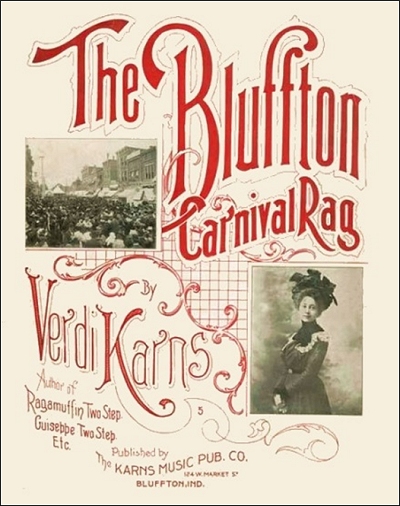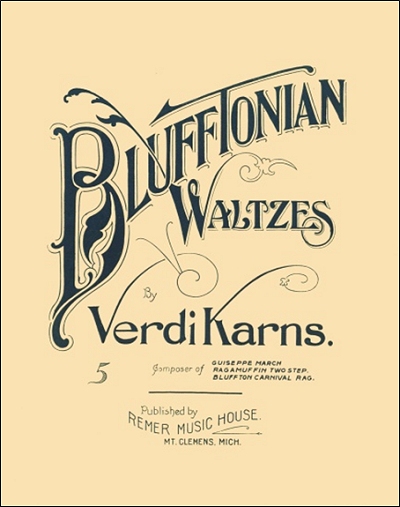Verdi Karns was born in Bluffton, along the Wabash in northeast Indiana, the only child of Lewis Henry Karns and Olive Covert. She was reportedly named after the famous Italian composer Giuseppe Verdi. The 1880 census showed Lewis working as a marble cutter and living with his family, except for his brother who was next door. Also on the same page was the Sturgis family, two doors down, the as yet unnamed infant son who would eventually marry Verdi. A few more doors down from them lived part of the Covert family, although Olive's parents' home was a few miles off. After the couple married on June 9, 1881, Alice gave birth to Verdi in April of 1882. However, she tragically died in August of 1884 at the age of 30, leaving behind her husband and young daughter.
After the couple married on June 9, 1881, Alice gave birth to Verdi in April of 1882. However, she tragically died in August of 1884 at the age of 30, leaving behind her husband and young daughter.
 After the couple married on June 9, 1881, Alice gave birth to Verdi in April of 1882. However, she tragically died in August of 1884 at the age of 30, leaving behind her husband and young daughter.
After the couple married on June 9, 1881, Alice gave birth to Verdi in April of 1882. However, she tragically died in August of 1884 at the age of 30, leaving behind her husband and young daughter.Verdi was initially raised by her father with help from his parents. However, by the 1890s Lewis Henry had remarried and moved to Kansas, leaving Verdi in nearby Harrison under the care of his cousin Lewis James Karns and his wife Melissa Covert, Olive's sister. The family received some welcome help upon the death of Olive's mother Eliza. In her will she left but one dollar to Olive's brother William Covert, as he had "already received his portion." The rest was left to her only living daughter, Melissa, for "the care of her grand-child, Verdi Karns."
With the encouragement of her aunt and uncle, Verdi found a clear enthusiasm for, and perhaps even a happy escape into music. The town certainly had music all around, as they were the home of the Starr Piano Company manufacturing plant, even though the main office was located in Richmond at the other end of the state. At age 16 with some help from her relatives Verdi started publishing her own works, including a couple of rags and a cakewalk, in addition to a set of waltzes. The latter piece, Blufftonian Waltzes, was picked up by the Remer Music House of Mt. Clemens, Michigan. The Bluffton Carnival Rag had been written specifically for a street fair and agricultural exhibit held in town in starting in 1898. It was later reissued by Remer in 1905. One other interesting piece from 1899, Giuseppe March, was likely composed in honor of her reported namesake.
The local paper, The Bluffton Banner, published a short feature on Verdi in their December 6, 1899 edition:
Bluffton has gained a reputation in a good many ways, and has become known to people far and wide. Not only is she known for her fine streets, her excellent schools and the generally high character of her inhabitants, but in addition to these things which speak volumes for Bluffton, there are many bright artistic talents to be found among our young people. Among this class of talented young people is Miss Verdi Karns, who is the author and publisher of several fine musical selections. The first of these is "Guiseppe" [sic] March, published about two years ago, of which a thousand copies have been sold. Last March she issued another popular selection, "Ragamuffin" Two-step, which is now in its second edition, and is still in good demand. Her last selection, "Bluffton Carnival Rag," [sic] written especially for the Bluffton street fair. This has proven very popular, and is having a large sale. Our music loving friends will find an extract from this selection in connection with this article.
Last March she issued another popular selection, "Ragamuffin" Two-step, which is now in its second edition, and is still in good demand. Her last selection, "Bluffton Carnival Rag," [sic] written especially for the Bluffton street fair. This has proven very popular, and is having a large sale. Our music loving friends will find an extract from this selection in connection with this article.
 Last March she issued another popular selection, "Ragamuffin" Two-step, which is now in its second edition, and is still in good demand. Her last selection, "Bluffton Carnival Rag," [sic] written especially for the Bluffton street fair. This has proven very popular, and is having a large sale. Our music loving friends will find an extract from this selection in connection with this article.
Last March she issued another popular selection, "Ragamuffin" Two-step, which is now in its second edition, and is still in good demand. Her last selection, "Bluffton Carnival Rag," [sic] written especially for the Bluffton street fair. This has proven very popular, and is having a large sale. Our music loving friends will find an extract from this selection in connection with this article.Miss Karns has in preparation a song entitled "A Dream," of which she is composing both the words and music [This piece has not surfaced]. Miss Karns seems to have a remarkable talent for music, and for this reason has been given the best of opportunity to improve her talent. Her first selection above mentioned was named for her namesake, Guiseppe [sic] Verdi, a celebrated Italian composer.
The 1900 enumeratin showed Verdi still residing with her aunt and uncle, with Lewis J. working as a druggist, and the 18-year-old girl showing no occupation in spite of her musical activities. This included being part of the local Symphony Club as their pianist. Having graduated from Bluffton high school, she was soon on her way to Indianapolis, Indiana, likely in late 1901, where she studied advanced music in the Conservatory of Music, the same one where many of the famous Indianapolis composers had received their training. Once she was back in Bluffton, Verdi performed with the city orchestra for a number of events, and also played for weddings and similar occasions. One more piece was self-published in 1905, a song written with Laverne Brown of Bluffton.
On October 20, 1908, Verdi was married to her former neighbor Raymond Sturgis. According to the Bluffton Chronicle of September 16, 1908:
...The bride-elect is a daughter of L.H. Karns, but since a small girl she has made her home with her uncle, L.J. Karns, the druggist. She is an accomplished young woman in many lines and is a musician of marked ability. She is also a graduate of the Bluffton high school. Mr. Sturgis is a son of Captain E.Y. Sturgis and completed a course in law at Ann Arbor and at Indianapolis. He is the junior member of the law firm of Sharpe and Sturgis and is a young man who has a promising future in his profession.
The 1910 census showed the couple in Bluffton living with her elderly aunt and uncle, with Verdi now engaged in the art of painting china as an occupation. She also enjoyed tatting, a form of creating durable lace objects with knots and loops. By 1911 Ray had purchased a Bluffton print shop. Their daughter Olive was born on Christmas day of 1912.
In 1914 Verdi showed signs of tuberculosis and the diagnosis suggested that the Karns should retreat to a drier climate to combat the sickness. They relocated southwest to Albuquerque, New Mexico, where Ray got a job with a printing plant. His 1918 draft record showed him managing the printing facility for the Albuquerque Evening Herald, which was also a local print jobber. The 1920 census taken in Albuquerque showed that Verdi's widowed aunt Melissa was now residing with the couple and their daughter.
The change in climate likely extended Verdi's life, but they eventually moved to Phoenix, Arizona in the early 1920s where it was even drier. Verdi passed on in Phoenix in 1925 just three weeks shy of her 43rd birthday. She was buried in Bluffton.

 Compositions
Compositions